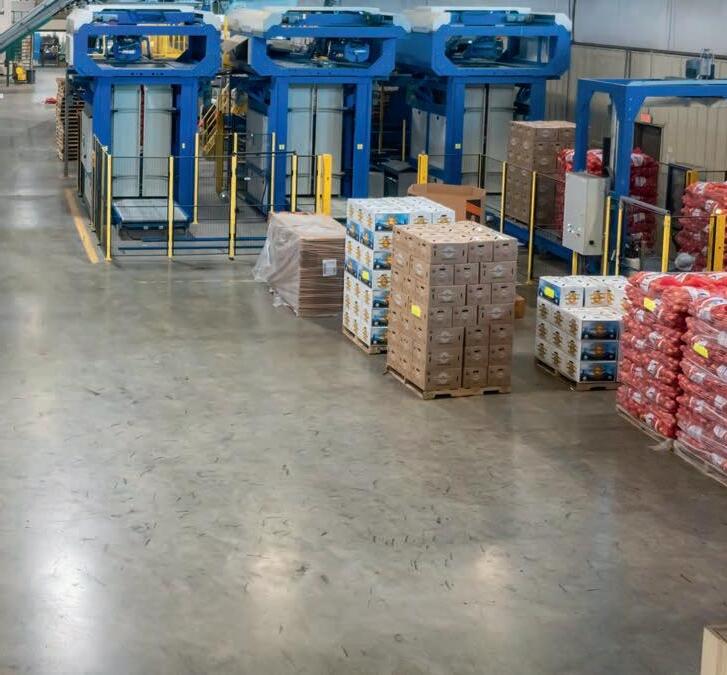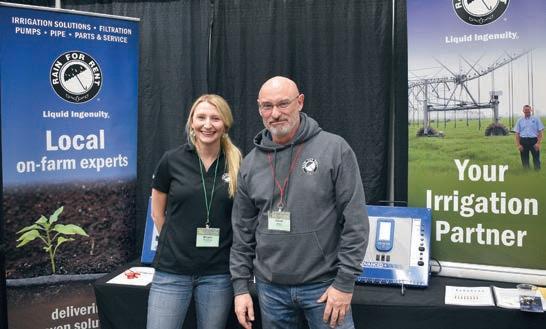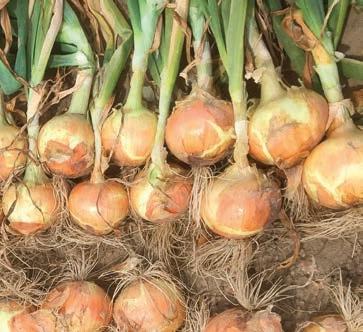


















PO Box 333
Roberts, Idaho 83444
Telephone: (208) 520-6461
Circulation: (503) 724-3581
OnionWorld.net

ONION WORLD CONTACTS
Editor Denise Keller editor@ColumbiaMediaGroup.com
Publisher / Advertising Manager

Dave Alexander dave@ColumbiaMediaGroup.com
Director of Operations
Brian Feist brian@ColumbiaMediaGroup.com
EDITORIAL INFORMATION
Onion World is interested in newsworthy material related to onion production and marketing. Contributions from all segments of the industry are welcome. Submit news releases, new product submissions, stories and photos via email to: editor@ColumbiaMediaGroup.com, or call (509) 697-9436.
ADVERTISING SALES
For information on rates, mechanics, deadlines, list rental, direct mail, inserts or other information, call (208) 520-6461 or email: dave@onionworld.net
SUBSCRIPTIONS
U.S. $24 per year
Canada $40 per year
Foreign $80 per year
Subscribe online at: www.OnionWorld.net/subscribe or call (503) 724-3581.
Email address changes/corrections to brian@ColumbiaMediaGroup.com or mail to:
Onion World PO Box 333 Roberts, ID 83444
Onion World magazine (ISSN 0892-578X), is published eight times a year and mailed under a standard rate mailing permit at Idaho Falls, Idaho and at additional mailing offices. Produced by Columbia Media Group PO Box 333, Roberts, ID, 83444. Copyright 2023. All rights reserved.
No part of this publication may be reproduced or transmitted in any form or by any means, electronic or mechanical, for any purpose without the express written permission of Columbia Media Group.
For information on reprints call (208) 520-6461.













To say farming is challenging is an understatement. These days, growers are faced with labor shortages, transportation issues, and rising input and fuel costs on top of the ever-present uncertainties of weather and commodity prices. In the last couple years, growers Curtis and Lisa Marble with CL Marble Farms in Corrine, Utah, have faced these challenges and more.
On 350 total acres, roughly 60 miles north of Salt Lake City, the Marbles grow small grains, corn, alfalfa, mint, pumpkins, and between 30 and 40 acres of yellow onions per year. Their onion crop is delivered to Onions 52 in bulk bins, where they get repacked, then sold and distributed to restaurants and grocery stores. When they have an onion crop, that is.
In 2021, the Marbles lost 40 percent of their storage onions to a disease previously unknown in Utah. Fusarium proliferatum was to blame for bacterial bulb rot and the resulting crop loss. This pathogen was last seen in Idaho in 2014 but only lasted that one year.
Claudia Nischwitz with Utah State University said researchers don’t know why the pathogen causes onion bulb rot one year and then doesn’t show up for years. It is so rare that until recently, no research had been done on the pathogen in onions. Nischwitz and her students have started to study it, but since very little was known about Fusarium proliferatum in onions, they had to start with the basics. It is still unknown if it will show up in this year’s storage crop.

The university will have a field trial this summer and hopefully more information next fall.
After the terrible 2021 season, the Marbles planted 2022 seed into ground that had good moisture, but the region had no precipitation after planting. The soil on top was very loose from working the ground for planting preparation. Then strong winds moved the soil, which filled up the furrows, and intense, windblasted sand sheared off the onion plants at ground level.
Marble was told by his insurance agent to disk up the field and insurance would cover the cost of the crop. He could have planted corn or something else, but decided he wanted to grow onions in that

Lancaster & San Joaquin Valley

(661) 9785342
Desert Southwest
(928) 4467737
Colorado & New Mexico
(970) 3969728
Idaho, East Oregon, Utah & Nevada
(208) 9411421



Skagit Valley, Washington

(360) 9417503
Rio Grande Valley & West Texas





(956) 6185574
Torreón, Coahuila
(461) 1173878
Colima, Col.
(461) 1040134

San Luis Potosi
(461) 1409452
Chihuahua
(461) 1719401
Tamaulipas

(461) 1342421
Irapuato, Gto.
(461) 5465792
Our proven accurate seed placement is why growers have continued to purchase our planters over these many years.


Special inner and outer singulators removes doubles to insure placement of individual seeds.


All planters are assembled and tested at our plant in Chino, California, to insure accuracy.


field despite being about 30 days behind at that point. Marble said he didn’t plant onions to just dig them up. The resulting insurance payment barely covered the cost of the seed to replant.
“I am not a fan of insurance, and it’s not worth the paper it’s written on. Insurance is a necessary evil,” Marble said, adding that he thinks rather than just insuring the crop, whole farm insurance is a better option because the revenue of the entire farm is covered.

After 35 years of growing onions, Marble said the farm’s soil is “past the new soil stage,” so they rent ground as much as they can to keep them in the onion business. But Marble said that the Joaquin yellow variety is very good for tired ground and does well in the area.
“In ground that’s had onions in it year after year, Joaquin still produces very well,” he said.




The Marbles will normally grow onions for two years in a row on the same floodirrigated ground and then stay out of it for eight years. On those off years, mint, pumpkins and winter squash are grown on those plots.
Lisa Marble handles the pumpkin business that has turned out to be a very lucrative market for the farm. They supply pumpkins to a regional chain of grocery stores, as well as farmers markets and fruit stands throughout the state of Utah.

“It pays off very well,” Marble said. Mint has also been a good source of revenue for the farm. The mint oil they distill onsite ships to Meridian, Idaho, for use in products such as gum, candy and toothpaste.






Curtis’ grandfather started the operation, followed by his father from whom he bought the farm. In fact, Marble Farms is recognized by the Utah Farm Bureau Federation as a Century Farm, one that has been continuously owned by a single family for 100 years or more.
Despite having to replant his sawed-off onion plants, 2022 was a rebound year for Marble Farms after the disastrous 2021 diseased crop. Marble said he was very pleased with the 2022 harvest and characterized the season as a 9.5 on a 1-to-10 scale.
















Even with the difficulties Marble Farms has faced in the last two seasons and before he knew of the 2022 crop’s success, Marble maintained a positive and upbeat attitude and accepts challenges.

“Farmers are optimists. That’s the business we’re in,” Marble said. “I’m an onion farmer. I have been for over 30 years, and I intend to keep doing that.”



Without the availability of Lorsban (chlorpyrifos) to control seedcorn maggot, onion growers are looking for alternatives. A 2022 research trial has put other options to the test and identified insecticides to manage this damaging pest.
Seedcorn maggots are the larvae of a small fly species (Delia platura). The first generation of this pest emerges from the soil as adult flies; they resemble small house flies. The flies mate, and then the females lay eggs on the soil or in plant residues in the soil. Each female lays about 270 eggs. The eggs hatch readily at temperatures as low as 50 degrees Fahrenheit, and they may only take a week or two to hatch. The emerging maggots feed on the tender tissues of germinating seeds and young seedlings. Later, they pupate to start the cycle again. Seedcorn maggots cycle through three to five generations per year.
Onion seedlings are most vulnerable to injury during growth stages from germination, flag leaf emergence, and up to emergence of the first true leaf, so seedcorn maggot larvae that hatch then are the most destructive to onions. Feeding injury during the most susceptible stages can result in significant stand loss and stunting, which can negatively impact onion bulb size and yield at harvest. In some cases, replanting may be necessary to achieve an acceptable crop.
Practices that promote rapid germination and emergence can reduce stand loss by shortening the window of greatest vulnerability to injury: 1) plant into moist (but not excessively wet) soil because onion seeds need adequate moisture to germinate and emerge; 2) delay planting until soils have warmed because germination is quicker at soil temperatures above 52 degrees
Fahrenheit; and 3) deep planting can delay emergence, so a shallow depth of 0.25 inch to 0.75 inch is recommended for most soils, and up to 1 inch if moisture is limited.
Damage from seedcorn maggot feeding tends to be more extensive when there are a lot of organic residues like animal manure, green manure and stubble in the field. Adult flies are attracted to decaying matter and prefer to lay eggs in fields with residues. Incorporating residues into the soil to promote decomposition several weeks in advance of planting can be an effective cultural management practice because the residues should be mostly decayed and should attract fewer flies when it is time for planting.
Applying insecticides preventively, as a seed treatment or an in-furrow application, has proven to be the most reliable way to minimize damage from seedcorn maggot. Many onion growers were using Lorsban (chlorpyrifos) to control seedcorn maggot, but this product can no longer be used.
What are the next best options?
In 2022, a trial was conducted in the Columbia Basin of Washington state to identify insecticides that can help onion growers control this pest.
The trial was planted in late March in Pasco, Washington. The experimental design was a randomized complete block with six replicates of seven insecticide treatments and a non-treated check. Application timing and method differed among treatments; ST = seed treatment, PPI = preplant banded and mechanically incorporated, POST = banded and watered in 10 days after planting. Some of the insecticides are not labeled for use on onions, or for the use described, but
they were included in the trial to explore possible options for the future. Stand counts were done on May 11 and May 31 to assess treatment performance.
• Non-treated
• FarMore FI500 (ST)
• Regard (ST)
• Diazinon 600 at 102 fl. oz/acre (PPI)
• Diazinon 600 at 102 fl. oz/acre (POST)
*not a labeled use
• Verimark at 10 fl. oz/acre (POST)
• Exirel at 18 fl. oz/acre (POST)
*not a labeled use
• Capture LFR at 8.5 fl. oz/acre (POST)
*not a labeled use
The results of the 2022 trial demonstrate that onion growers have options to control seedcorn maggot in 2023 (Fig. 1).
Diazinon (diazinon) (IRAC Group 1) – This product led to the best stands in the trial when used at the highest labeled rate (102 fl. oz./acre) as a preplant application. The application after planting (not labeled) did not perform quite as well. The pre-plant application of diazinon is an option onion growers can use now, but it looks like diazinon has a limited future; it is not likely to be reregistered when it comes up for review by the EPA.
Capture LFR (bifenthrin) (IRAC Group 3) – This product performed well in the trial, but it is not registered for use on onions. Capture LFR will be included in a Western Region IR-4 trial in 2023 to gather data to support its registration for use on onions to control seedcorn maggot. It shows promise as a potential “rescue treatment” to control unexpected infestations or infestations that were not controlled with preventive pre-plant or at-plant insecticides. It is currently registered for use on crops like beans and peas, coriander and sweet


Non-treated
FarMore FI500 (ST)
Regard (ST)
Diazinon (PRE)
*Diazinon (POST)
Verimark (POST)
*Exirel (POST)
*Capture LFR (POST)
*Experimental, not a registered use.
May 11
corn, and can be applied pre-plant incorporated (PPI), at-planting, or as a pre-emergent (PRE) or foliar application.
FarMore FI500 (fungicides, thiamethoxam and spinosad) (IRAC GROUP 4A and 5) – This seed treatment demonstrated effective control of seedcorn maggot in this trial and in many previous trials conducted in the Columbia Basin. Spinosad is the heavy hitter in this one, but thiamethoxam assists. FarMore FI500 (with spinosad) will not be available in 2023 because Syngenta will no longer have access to spinosad, a Corteva product. However, onion growers can combine products to use the same set of active ingredients (see below).
Regard (spinosad) or Lumiverd (spinosad) (IRAC Group 5) – This seed treatment controls seedcorn maggot, but we recommend combining it with a thiamethoxam seed treatment (see below). Instead of Regard, onion growers can use Lumiverd (spinosad) in 2023.
May 31
FarMore FI400 (fungicides, thiamethoxam) + Lumiverd (spinosad) (IRAC Group 4A and 5) – FarMore FI500 (with spinosad) is no longer available, but onion growers can use FarMore FI400 + Lumiverd in 2023. Lumiverd is an important addon to the seed treatment because thiamethoxam alone will not provide adequate control of seedcorn maggot under most situations. However, we recommend using FI400 (fungicides and thiamethoxam) rather than FarMore FI300 (just fungicides) in combination with Lumiverd (spinosad) for the previously mentioned reasons.
Some of the pesticides discussed in this report were tested under an experimental use permit granted by the Washington State Department of Agriculture. Application of a pesticide to a crop or site that is not on the label is a violation of pesticide law and may subject the applicator to civil penalties. In addition, such an application may also result in illegal residues that could subject the crop to seizure or embargo action. It is your responsibility to check the label before using the product to ensure lawful use and obtain all necessary permits in advance.
The 63rd annual meeting of the Idaho and Malheur County growers’ associations took place Feb. 7 in Ontario, Oregon. This is a one-day event with a bustling trade show and long list of speakers.

Stuart Reitz with Oregon State University took to the podium in Ontario to tell attendees that an integrated pest management approach is needed to minimize damage from maggots. In the western U.S., there are two species that cause growers problems – the seedcorn maggot and the onion maggot. The seedcorn maggot can be found on onions, seed corn (as the name implies), potatoes, decaying organic material in the soil, and other seeded crops. The onion maggot is an Allium specialist, infecting onions, garlic and shallots.
The first generation of maggots can be the most damaging to crops, Reitz said, because plants are very small. Any maggot feeding at that point will kill plants. Later generations in the summer will not cause direct yield loss. Another generation comes in late-summer and fall harvest season that can overwinter and cause problems the next spring. Reitz recommends limiting volunteers and culls left in the field and covering up cull piles to reduce the first generation of maggots in the spring.
Seedcorn and onion flies use olfactory clues to determine egg laying. Flies are attracted to decaying organic matter, recently tilled soil or tilled-in cover crops, recent manure and compost applications, as well as volunteer onions and cull piles, which should be disposed of. Reitz also recommends not planting near cull piles or last year’s onion fields and avoiding
back-to-back onions.
Insecticides are a key part of maggot management, but there are no rescue treatments, Reitz said. Insecticides need to be applied preventively.
“Insecticides for adult flies are a good way to waste money. It’s completely ineffective. Save your money and use those resources in other ways to control the problem,” Reitz said.
With the insecticide Lorsban off the table for growers this year (see story on page 10), Reitz has been looking at seed treatments and other solutions.
In his 2022 trials, Reitz used a seed treatment without insecticides in his untreated check and had 98 percent stand loss after the first maggot generation. Reitz tested the standard treatment, FI500 from Syngenta, which has three fungicides, plus two insecticides. This treatment, containing
Bejo’s new Colt variety (BGS 372) highlights the Gowan Seed Company booth in Ontario. The new yellow onion is a 118-day storage variety with attractive size, scale and firmness. Gowan says it has extended storage potential and is an excellent complement to Hamilton.


















Let's use these skills to increase consumption through the Nature's Ninja Marketing Program.


Call (970) 353-5895 to learn more.
Regard and Cruiser insecticides reduced losses by 75 percent. In a trial with Regard only, losses were reduced 70 percent. Spinosad-based Regard has proven effective against both seedcorn and onion maggots.

Corteva had an arrangement to supply Regard to Syngenta, but that agreement has recently ended. Reitz said a good option for western growers this season is to use seed treatments with a combination of FI400 and spinosadbased Corteva Lumiverd. This will provide protection from wireworms, white grubs and both species of maggots, and it also contains fungicides.

During the annual meeting, new members are inducted into the Treasure Valley Onion Hall of Fame. This year, the honors went to Herb Haun and Jerry Baker.
Herb Haun grew up in Weiser, Idaho, and started in the onion business at age 14 by sweeping out Parson’s Packing Shed. After serving in the U.S. Air Force and the Idaho National Guard, he went to work at Parson’s fulltime, starting as
the shed foreman and then moving into sales.

Haun has been on the Idaho-Eastern Oregon Onion Marketing Order Committee for over 20 years and served as chairman from 2006 to 2012. In addition, he served as the Idaho-Oregon Fruit and Vegetable Association president from 1989 to 1990.

Haun and his wife, Kelly, have two children and seven grandchildren.
Jerry Baker grew up in Vale, Oregon, where he worked on his family dairy farm and bucked onions for local growers. Later, he worked as a produce inspector for the Oregon Department of Agriculture Inspection Service. He followed that with three years at Ore-Ida, managing the fresh pack potato and onion department and doing fieldwork and onion sales.
Baker ran DeBruyn Produce for over 20 years, eventually purchasing the business
and turning it into Baker Packing.
Baker served on the Idaho-Eastern Oregon Onion Marketing Order Committee for over 20 years. He was president of the Idaho-Oregon Fruit and Vegetable Association from 1977 to 1978 and has served on the State of Oregon Inspection Advisory Board for over 50 years.
Baker and his wife, Judy, have seven children, six grandchildren and 17 greatgrandchildren.


Redox Bio-Nutrients has incorporated a fleet of ChrysaLabs probes in its soil testing. ChrysaLabs has developed a portable AI-based soil health probe that measures 37 soil nutrients and characteristics in real time. The company describes the probes as each containing their own laboratory. Combining a patented spectroscopy interface and the latest AI possibilities, the optical technology measures the soil properties at 360 degrees, with a large contact surface, at any depth, and without preparation. Soil is analyzed in less than a minute, according to the company, saving producers and agronomists time waiting for traditional lab analysis.
Visit www.chrysalabs.com.
Certis Biologicals has launched its new copper product Kocide 50DF (copper hydroxide) for specialty crops in all states. The high-load copper biofungicide is designed to serve as both a preventative and curative product to combat a variety of fungal plant diseases, including bacterial blight, downy mildew and purple blotch in onions.

The new Kocide 50DF formulation mixes with low dust residue, is easy to pour and disperses into the mix solution quickly, producing even coverage during application, according to the company. The product can be applied through foliar, aerial spray, sprinkler chemigation or ground boom application methods.
Visit www.certisbio.com.
The 12-month profitability outlook from AgWest Farm Credit, formerly Northwest Farm Credit Services, suggests slightly profitable onion returns. According to the lender’s quarterly Market Snapshot report released in January, profitability in 2023 will depend on growing conditions and moisture. Producers with larger-sized onions in storage are well positioned to capture higher prices, given lower yields and shorter 2022 onion inventories across the Northwest. White and red onions in the Northwest, however, could face price pressure once Mexican onions enter the market. The report goes on to say that ongoing supply chain and input cost challenges will create headwinds for producer profitability.
June 14-17
National Onion Association Summer Convention

Amway Grand Plaza Hotel Grand Rapids, Mich. www.onions-usa.org
Aug. 8
Utah Onion Summer Field Tour
Weber County, Utah
Dan Drost, dan.drost@usu.edu or (435) 770-4484
Aug. 22
The Bayer Experience Featuring Onions, Specialty Crops and More Payette, Idaho
Richard Navarrete richard.navarrete@bayer.com or (208) 317-6451

Editor’s note: To have your event listed, please email Denise Keller at editor@ columbiamediagroup.com. Please send your information 90 days in advance.

 By Dante Galeazzi, Executive Manager, South Texas Onion Committee
By Dante Galeazzi, Executive Manager, South Texas Onion Committee



Despite an uncharacteristic December freeze, the warmer-than-average fall and winter have put Texas onions on a trajectory to be ready ahead of the typical St. Patrick’s Day kickoff.



Many farmers in the subtropical Rio Grande Valley are looking at great stands of onion fields in late January that will likely be ready weeks ahead of their typical start. The 80-degree days from most of December and January have played a big role in giving those onions the heat units needed. Plus, the occasional rainstorms the region has experienced since September have all contributed to the positive and healthy growth of this year’s crop.
The season in South Texas typically sees plantings begin in August and September and go through early January, with harvest running from late February into late June and peak shipping volume occurring in April and May.
Acreage for this year is up considerably in South Texas – both in the Rio Grande Valley and Uvalde-Wintergarden growing regions.
Many in the industry expected the increase in plantings after strong sales throughout the 2022 year – not just the Texas 2022 season. And the increase can be seen in all colors.
For those unfamiliar with the Texas fresh onion industry, growers focus primarily on the Texas 1015 Sweet Onion as their premium product. These varieties are short-day sweet onions that are commonly grown for sizes in the large-mediums and jumbos, as they make a great retail grocery store item, which can be promoted as the “first U.S.-grown fresh onion of the season” and as the “granddaddy of all sweet onions.”


TANIA
New short day yellow granex introduction: Strong upright tops with great plant habit. High yielding deeper granex shape, strong root system, and firm bulbs. Pink root and bolting resistance.
Earliness: Early main

Sowing period: 09-15 - 09-25
Taste: Sweet
Pyruvates: 3.6

Lacrymatory Factor: 2.8
Shape: Granex

IR: Foc; Pt
Early maturing grano red. Strong healthy tops. Pink root resistance. Excellent bulb firmness and color. Uniform round bulbs. Good internal color. Widely adapted across short day growing regions. High percentage single centers.


Earliness: Early
Sowing period: 09-25 - 10-05
Taste: Very sweet
Shape: Grano

IR: Foc; Pt
Late season short day yellow granex with upright tops. Deeper high yielding granex shape. Bolting resistance and very uniform. Strong outer skin layers. Produces well sized bulbs that result in good yields. Great option to fill later season slot in Vidalia.
Earliness: Late
Sowing period: 09-25 - 10-05

Taste: Very sweet
Pyruvates: 3.5
Lacrymatory Factor: 2.4
Shape: Granex IR: Foc; Pt
Main Season short day yellow granex. Attractive lighter colored skin. Uniform and extra firm bulbs with high yielding deeper granex shape. High percentage of jumbos. Great post harvest appearance. A widely adapted variety across many short day regions.
Earliness: Main
Sowing period: 09-18 - 09-28

Taste: Sweet
Pyruvates: 3.4
Lacrymatory Factor: 2.6
Shape: Granex IR: Foc; Pt
Reds, whites and yellows are grown in the region to complement the sweet onion crop. A vast majority is conventionally grown, although there is some regular organic production by several growers who have found success in their production models. The pest and disease pressures associated with the conditions in South Texas have prevented many from entering or expanding their organic onion crops.

Due to the high water content of the onion varieties used in Texas, mechanical harvesting is not being used throughout the region, which has left growers challenged to find sufficient harvesters, similar to many fresh produce growers throughout the country. Varieties which are conducive to mechanized harvest, retain the traditional flavor and size traits, and work with the conditions in South Texas will be needed to support the research being done on machinery adaptions.



The growers in South Texas are always looking to capture a longer window of opportunity, primary on the front of the season in February. Going later brings competition from multiple regions such as Georgia, New Mexico and California. But in January and February, there are few options for non-storage onions. Production systems and seeds which would support a late January harvest with a mid-February start for shipping could expand the season for Texas growers by a full month and create an opportunity that gives the growers market access four to six weeks ahead of the next region.

CaTs
CaTs is a 100 percent water-soluble calcium with a 0-0-10S-6Ca analysis. CaTs applied through the irrigation system can supply much needed calcium and sulfur at critical growth and uptake times. Recent onion trials with CaTs in the Pacific Northwest have shown both increased yields and improved storability.
Polysulphate is the only naturally occurring fertilizer delivering four essential nutrients, all in sulfate form: potassium, sulfur, magnesium and calcium. Every granule of Polysulphate contains naturally balanced nutrition for uniform distribution across fields and maximum soil productivity. Low chloride and pH neutral, Polysulphate is extremely safe and ensures onions reach their highest quality and yield potential. Polysulphate is well suited for blending with most standard fertilizers and is fully soluble.

Biomin
Biomin is a line of fully chelated plant nutrients resulting from the chelation of mineral nutrients with amino acids. These chelates protect the nutrient from combining with other elements or losing nutrient value for absorption. JH Biotech’s Biomin chelated line is OMRI, CDFA and WSDA organic certified and compatible with humic and fulvic acid products. Without using harsh chemicals, it provides plants with stable nutrients, balancing mineral deficiencies more quickly than conventional inorganic nutrients. It can be used for soil and foliar applications without compromising environmental quality and safety. Biomin may be applied to all crops and turf. It reduces the effects of saline soils, water deficiency and weather conditions while encouraging increased yield, homogeneous ripening, more flavored and high quality fruit, and greater nutrient absorption.

Nutri-Cal • www.nutri-cal.com
Nutri-K

The product works when the T.O.G. complexes the elemental potassium ion, which subsequently allows the ion to be absorbed directly and immediately through the leaf and fruit cell walls.
Agri •
Nanocal
Omex
Slyce Ca8% provides organic compounds, feeding soil microbial activity, which increases the soil-available fertility, especially when applied after granular fertilizers (e.g., DAP, MAP, CalSul or KCl), by reacting with those granular nutrients to release their components for faster and more efficient fertilizer use by plants.



we are, over halfway through the first quarter of 2023 already. With that comes the National Onion Association’s (NOA) annual Washington D.C. Fly-In, held Feb. 26 – March 2. Although this trip is a lot of work for all who attend, it is vital in order for onion growers and the onion industry as a whole to continue to operate and function the way that it does.
Not only do we meet with many senators, representatives and their aides, but we also meet with groups such as the EPA, FDA and National Transportation Committee. We discuss a wide variety of topics, including labor issues, IR-4 funding, transportation concerns, chemical labeling, irrigation water testing protocols and the recent concerns of Salmonella. The issues are broad and wide-sweeping, and all of them are issues that concern the viability of our industry. It is vital that every year, a group of us from the NOA set out on this trip to make certain that our voice is heard in Washington D.C.
I have been on this trip five or six times now in my nearly 20 years in the industry, and I can’t explain how important that I
Herebelieve every issue we address on this trip is. I also believe that everyone we sit down and speak with is happy to see and hear from us. We are the boots on the ground, and many of the suggestions and requests we make on an annual basis are heard. There is follow-up and follow through, and it is a great thing to know that our donated time and energy is making a difference for the entire U.S. onion industry.
I have been attending NOA meetings with my father since I was a young boy. My first memory of an NOA meeting was one summer in the mid-1980s. I must have been around 8 or 9 years old (I’m currently 43) and probably remember the trip because we drove 12 hours from Colorado to Las Cruses, New Mexico. When you are 8 years old, a 12-hour drive might as well be a week. Anyhow, my point is that I have been attending these NOA conventions for a pretty long time. Although the NOA is widely regarded as a growers’ convention, I’m here to lobby anyone in the onion industry, no matter what part of it you belong to, that the NOA is so much more than just a growers’ convention.
The NOA hosts two annual conventions each year. The first meeting of the year is in mid-July and, generally speaking, is in or near an onion production area. The second meeting is usually the week
following Thanksgiving and is somewhere warm and beautiful. The amount of networking I have done over the years at these meetings is really overwhelming. I have met so many amazing people connected to the industry. Many of these people, I now consider lifelong friends that I speak with on a weekly basis. I have been to their businesses, their homes and, in a few cases, to their weddings and their children’s weddings. When you get invited to a wedding, you know you have crossed over into a friendship that will always mean far more than the business ever will.
I am not here to tell you to join the NOA. Although you should, and you should attend the meeting; you won’t ever be sorry that you did, I promise. What I am actually here to stand on my soapbox and beat the drum for is being involved and participating in our onion community.
I grew up playing lots of sports as a child and went on to play college football on some really, really good teams. I found that what stood out about us versus the other teams is that everyone on our team wanted the ball to make the big play, and no one ever shied away from being the guy that made that goal-line-saving tackle. Nobody shied away from that moment. Nobody was waiting for someone else to make that play.
Our onion industry has a lot of teammates on the sidelines right now waiting for someone else to make the play. We need everyone’s participation, everyone’s opinions and everyone’s ideas right now. We are facing more and more challenges from so many different angles each day, and they only seem to grow every year. No matter what part of our onion community you come from, whether you are a grower, packer, shipper, buyer, broker, transportation specialist, or equipment and material supplier, we need your participation. Get off the bench and get involved. There is strength in numbers, and education is power. Find a place to donate your time, energy and efforts to the onion industry in some form or fashion and help make a difference for our entire onion community. Go, onions!
Edp Electro-bagger model EB 2218 DF
This model now has the ability to do bags as well as cartons with the new touch screen controls. It also comes with pneumatic bag clamps as standard equipment.
For more information visit chinookequipment.com or call 800-219-2245 or 208-331-1126





San Joaquin Valley Russ Brown, Area Manager (559) 799-0799


Imperial Valley & Yuma AZ Scott Richards, Area Manager (928) 580-2484

Texas Clegg Smith, Area Manager (956) 340-0022

®


















